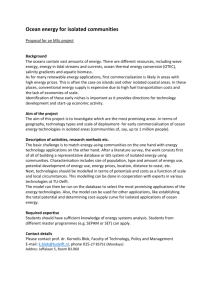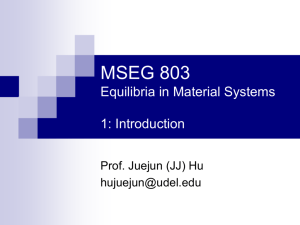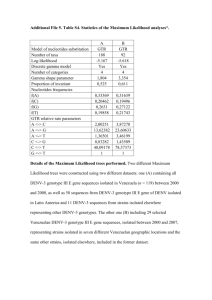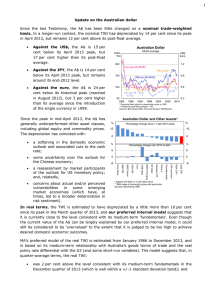Lecture Slides
advertisement
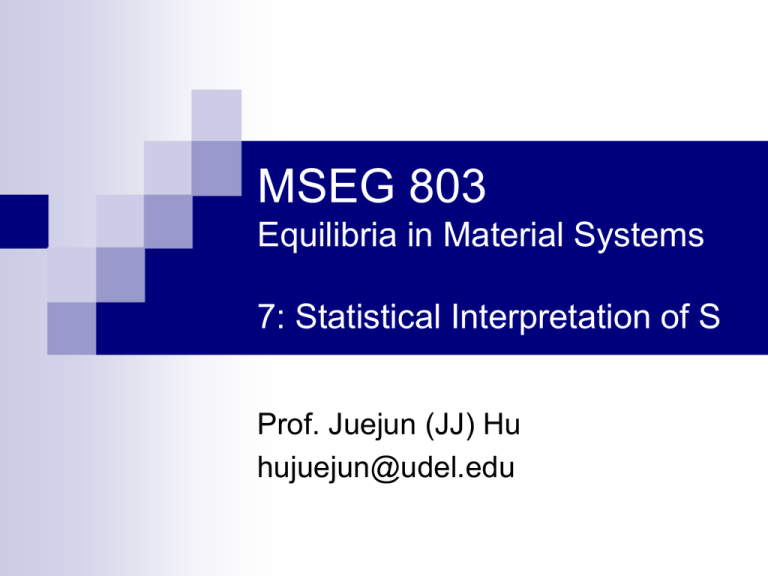
MSEG 803 Equilibria in Material Systems 7: Statistical Interpretation of S Prof. Juejun (JJ) Hu hujuejun@udel.edu Thermal interactions: heat transfer 600 mental copies of macroscopically identical systems E 300 300 E pi Ei e 3e 2e e E Q 150 150 300 e 0 E pi Ei 0.5e Thermal interactions (heat transfer/diabatic interactions): the energy levels remain unchanged The relative number of systems in the ensemble which are distributed over the fixed energy levels is modified Mechanical interactions: work 600 mental copies of macroscopically identical systems E e 300 300 E W E pi Ei e 5 5 30 30 50 50 190 190 3e 2e 50 e 0 E pi Ei 0.5e Mechanical interactions (work/adiabatic interactions): the energy levels are modified due to change of external parameters (some state functions, e.g. volume, magnetic field, etc.) General interactions Ensemble average of system energy: U E pi Ei First law of TD: dU d E Q W d E d pi Ei pi dEi Ei dpi Work: energy level change Quasi-static work: W pi dEi pi Heat: population distribution change dEi dE dx dx pi i y dx dx dx dEi d E Mean generalized force: y pi dx dx Example: particle in a box 2 2 2 n n n y 2 x 2 2 z 2 f ( Lx , Ly , Lz ) Energy levels: E 2m Lx Ly Lz 2 where nx and ny are integers (quantum numbers) Heat transfer: population distribution over levels changes, i.e. the “box” is held unchanged and only the quantum numbers nx, ny, and nz change Mechanical work: dimension change of the “box” leading to modification of the energy levels Example: ideal gas N DOS: ( E ) BV E 3N 2 f ( E,V ) U, T, V Heat transfer U + dU, T + dT, V Mechanical work U + dU, T + dT, V + dV Equilibrium condition in isolated systems N, Vi DOS of a composite isolated system consisting of sub-systems: f ( x1 , x2 ,..., xn , y1 , y2 ,..., yn ) xi: external parameters yi: internal constraints (usually extensive variables of sub-systems) Example: ideal gas in a cylinder with a partition Internal constraint y: mole number in the sub-systems Accessible states only include those satisfy the constraint, i.e. all gas molecules have to reside on the left side of the partition Equilibrium condition in isolated systems Remove constraint N, Vi N, Vf > Vi Removal of constraint(s) leads to increased (or possibly unchanged) number of accessible states and re-distribution of some extensive parameter(s) f i Probability of the system remaining in the constrained states: Pi i f ~ 0 Example: ideal gas in a cylinder with a partition Accessible states now include all states where gas molecules are free to distribute in the entire cylinder Equilibrium condition in isolated systems P y V1 V2 N1, V1 N2, V2 N1 N 2 N P N1 N! N1 ! N 2 ! y Probability of parameter y taking the value between y and y + dy P( y ) ( y ) If some constraints of an isolated system are removed, the parameters of the system tend to re-adjust themselves in such a way that approaches maximum: ( y1 , y2 ,..., yn ) max imum Fluctuations Random deviations from statistical mean values Exceedingly small in macroscopic systems Fluctuations can be significant in nanoscale systems A transistor (MOSFET) with a gate length of 50 nm contains only ~ 100 electrons on average in the channel. Fluctuation of one single electron can lead to 40% change of channel conductance! From Transport in Nanostructures by D. Ferry and S. Goodnick Statistical interpretation of entropy The function S has the following property: the values assumed by the extensive parameters in the absence of an internal constraint are those that maximize S over the manifold of constrained equilibrium states. Entropy: S k ln An isolated system tends to evolve towards a macroscopic state which is statistically most probable (i.e. a macroscopic state corresponding to the maximum number of microscopic accessible states) Isolated composite system Thermal equilibrium Two sub-systems separated by a rigid, diathermal wall U tot U1 U 2 cons tant A Q B tot U1 tot 1 U1 2 U 2 Apply the maximum principle of d tot 0 d ln tot d ln 1 d ln 2 0 U1 ln 1 ln 2 ln 1 ln 2 d ln tot dU1 dU 2 dU1 0 U1 U 2 U 2 U1 ln 1 ln 2 ln 1 T1 T2 (U ) U1 U 2 U kT Partition of energy f: degrees of freedom (DOF) of a system f ln ( E ) ln E E0 E0: ground state energy 2 1 ln f 2 ln E E0 f (U ) ~ kT U E 2E E 1 ~ kT f 2 The average energy per degree of freedom is ~ 0.5kT Equipartition theorem of classical mechanics: the mean value of each independent quadratic term in energy (DOF) is 1 2kT Dependence of DOS on external parameters as a function of volume ln S k P P V V kT p E + dE as a function of extensive parameter x of the system ln S k y y x x kT where y is the conjugate intensive variable of the system q E The 3rd law of thermodynamics At absolute zero (T = 0 K), the system is “frozen” into its quantum mechanical ground state S (T 0 K ) k ln ~ 0 where is the degeneracy of the ground state The Third Law of Thermodynamics by Katharine A. Cartwright (2010) watercolor on paper 26" x 20” Connections between TD and statistical mechanics S k ln Thermodynamics First law of TD: Statistical mechanics dU W Q Second law of TD: S max Third law of TD: S 0 when T 0K d E PdE i i Ei dPi Second law of TD: max i.e. d ln 0 i.e. dS 0 in isolated systems First law of TD: in isolated systems Third law of TD: System is frozen in its ground state when T = 0
